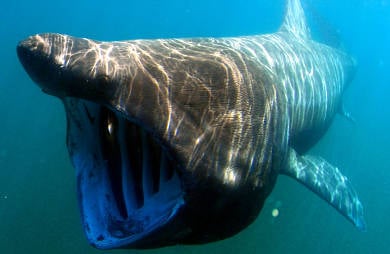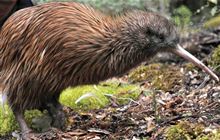New science report lists sharks as threatened
Archived content: This media release was accurate on the date of publication.
Introduction
The great white shark and basking shark have been classed as ‘threatened’ for the first time and the future of these species is not positive.Date: 28 June 2018 Source: Office of the Minister of Conservation

Basking shark
Image: Greg Skomal / NOAA Fisheries Service Creative Commons
The great white shark and basking shark have been classed as ‘threatened’ for the first time and the future of these species is not positive, a new scientific report released today by Conservation Minister Eugenie Sage says.
The New Zealand Threat Classification System report updates the conservation status of 113 species or types of sharks, rays and chimaeras (also known as ghost sharks) found in New Zealand waters.
“Great whites are long-lived and reach sexual maturity in over 28 years of age and live 70 years or more. It’s saddening that there are now so few of this giant of the ocean,” Eugenie Sage said.
The great white and basking shark have been classed as ‘threatened’ – a worsening of their previous ‘at risk’ status in the last report in 2005.
“New knowledge about great whites has confirmed an already suspected low adult population, which is either stable or in decline. A recent population estimate puts the number of adult great white sharks in New Zealand at between 590 and 750 and the total population including juveniles at 5460 sharks.
“We know less about basking sharks but the lack of sightings of this large plankton-eater in former coastal hotspots such as Cook Strait, Kaikoura, around Banks Peninsula and off Otago is cause for concern.
“We don’t know why basking sharks are declining in New Zealand waters, but it may be due to climate change and fisheries bycatch. Global population estimates for this species are low,” Eugenie Sage said.
Four shark species have been given an improved status of ‘not threatened’ due to new information. These are the Galapagos shark and Kermadec smooth-hound, which are protected within the Kermadec Islands Marine Reserve, and six-gill shark and Pacific sleeper shark, which are widespread deep-water fish.
“Just under half of New Zealand sharks, rays and chimaeras, 55 species, are categorised as ‘not threatened’ with large stable populations.
“But like much of the biodiversity in our vast marine area, our knowledge is patchy for this group; for over a third, 42 species, we don’t know enough to assess their status.”
This lack of knowledge is also illustrated by the 30 species in the report that have had name changes over the last decade, as well as the discovery of several previously unknown species.
The sandbar shark, slender electric ray and whitetip reef shark have all been newly reported in New Zealand waters and added to the list.
Sharks and rays protected under the Wildlife Act are white shark, basking shark, smalltooth sand tiger (deepwater nurse shark), whale shark, oceanic whitetip shark, giant manta ray and spinetailed devil ray (Japanese devil ray). White shark, basking shark and oceanic whitetip shark are also protected under the Fisheries Act, which prohibits the taking of these species on the High Seas.
New Zealand’s marine area, the Territorial Sea and Exclusive Economic Zone, is 15 times the country’s land area with diverse marine environments and ecosystems that are home to about 8000 known marine species.
Conservation status of New Zealand chondrichthyans (chimaeras, sharks and rays), 2016 (PDF, 7,439)
Further information:
- Great white sharks have been protected in New Zealand waters under the Wildlife Act since 2007. They are also protected from fishing by New Zealand vessels operating outside of New Zealand waters under the Fisheries Act.
- White sharks are classified as Vulnerable globally by the IUCN Red List of Threatened Species.
- The main threats to white sharks is bycatch in commercial and recreational fisheries and being fished for trophies.
- Basking sharks are classified as Vulnerable globally and Endangered in the Northeast Atlantic and North Pacific by the IUCN Red List of Threatened Species.
- Basking shark is a plankton filter-feeder and the world’s second largest fish (the whale shark is the largest). They reach at least 10.4 metres in New Zealand waters and are reported to grow to a maximum length of 12.2 metres.
Contact
For media enquiries contact:
Email: media@doc.govt.nz
For interviews with report author Clinton Duffy contact:
Fiona Oliphant, DOC Media Advisor
Mobile: +64 27 470 1378
Email: foliphant@doc.govt.nz


